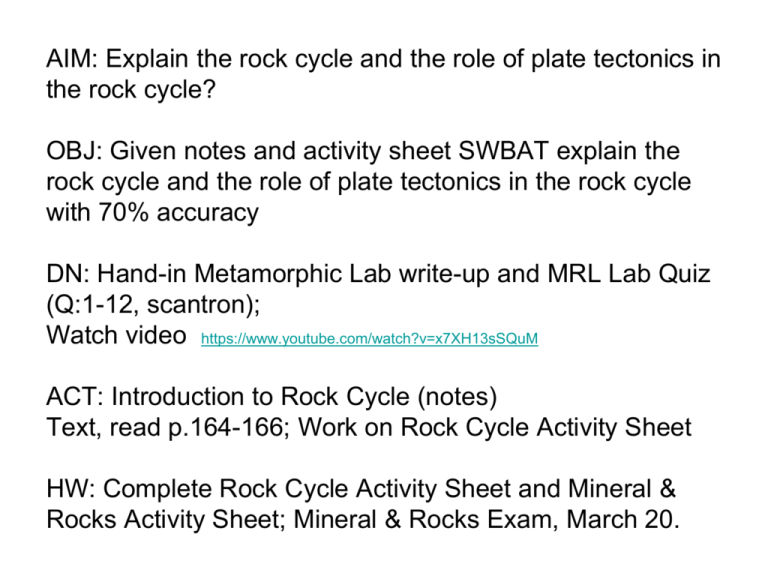Rock Cycle - Hicksville Public Schools / Homepage
advertisement

AIM: Explain the rock cycle and the role of plate tectonics in the rock cycle? OBJ: Given notes and activity sheet SWBAT explain the rock cycle and the role of plate tectonics in the rock cycle with 70% accuracy DN: Hand-in Metamorphic Lab write-up and MRL Lab Quiz (Q:1-12, scantron); Watch video https://www.youtube.com/watch?v=x7XH13sSQuM ACT: Introduction to Rock Cycle (notes) Text, read p.164-166; Work on Rock Cycle Activity Sheet HW: Complete Rock Cycle Activity Sheet and Mineral & Rocks Activity Sheet; Mineral & Rocks Exam, March 20. The Rock Cycle Forces deep inside Earth and at the surface produce a slow cycle that builds, destroys and changes the rocks in the crust. Rock Cycle: is a series of processes on Earth’s surface and in the crust and mantle that slowly changes rocks from one kind to another. Facts About The Rock Cycle (1) Plate Tectonics and Rock Cycle interlocked/united together. (2) Any rock can make any other rock: A Sedimentary Rock can produce a Igneous Rock, another Sedimentary Rock or a Metamorphic Rock. An Igneous Rock can produce another Igneous Rock, a Sedimentary Rock or Metamorphic Rock. A Metamorphic Rock can produce an Igneous Rock, a Sedimentary Rock or another Metamorphic Rock. (3) Sediments first before Sedimentary Rocks can be made. (4) Magma first before Igneous Rocks can be made. Facts About The Rock Cycle Rock Processes: (1) Magma: Melting Igneous Rocks: Solidification (2) Sediments: Weathering, Erosion Sedimentary Rocks: Deposition, Burial, Compaction, Cementation (3) Metamorphic Rock: heat & pressure (no melting) A Cycle of Many Pathways Igneous Rock: cooling & solidification of magma/lava. Plate Tectonics: uplift Sedimentary Rock: weathering, erosion (sediments), deposition, burial/accumulation, compaction & cementation (lithification). Plate Tectonics: plate collision, mountain-building, subduction Metamorphic Rock: heat & pressure (and chemical reaction) at great depth of any rock. Plate Tectonics: melting subducted plate, rising magma plume, volcanoes form at surface. The Rock Cycle & Plate Tectonics Igneous Rocks: Plate movements start the rock cycle by helping to form magma, the source of igneous rocks. Where plates move apart and where ocean/continental or continental/continental plates come together, magma forms and cools forming igneous rocks. The Rock Cycle & Plate Tectonics Sedimentary & Metamorphic Rocks: The collision of continental plates can result in uplift and mountain-building. The mountains eventually are worn away leading to the formation of sedimentary rocks. In addition, this collision can push rocks down deep into the mantle where heat and pressure changes the rocks into metamorphic rocks.







